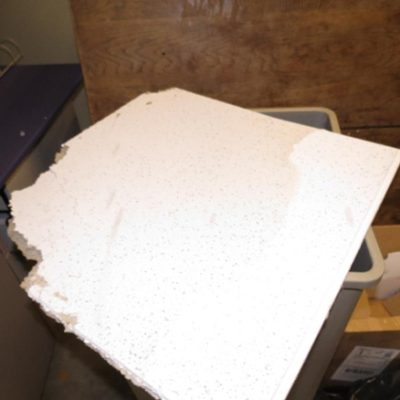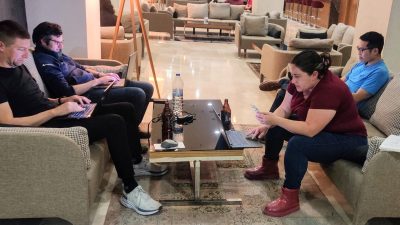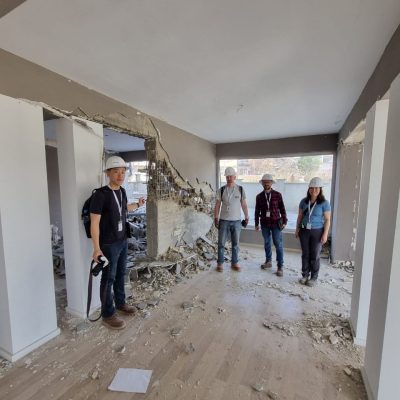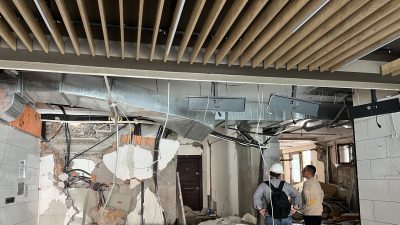Reflecting back on the Northridge Earthquake.
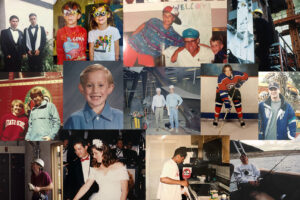
On January 17, 1994 at 4:30 am, a 6.7 magnitude earthquake hit the San Fernando Valley. The epicenter, originally thought to be located in Northridge, was actually located in nearby Reseda. On this 25 year anniversary, we reflect on where we were during and after the devastating earthquake.
Some of our employees experienced the earthquake first hand:

Anuj Bansal, Senior Principal and Southern California Group Director, Los Angeles
“We were living on the 2nd floor of a wood frame apartment building at the time. The earthquake was so noisy it felt like a train going under us. It made me realize how flexible wood frame buildings are and all that movement produces a lot of noise.”

Myron Curlee, Project Manager, Los Angeles
“I was 11 years old and was asleep in my bed on the second floor of my family’s townhouse near Baldwin Hills when the earthquake hit. I’m a light sleeper, so I woke up instantly. It felt like a gentle rocking…until the transformer outside around 25 yards from me exploded. Everything went black. The next day, I had no idea how much damage there was until watching the news. My school was fine, the houses of my grandparents and uncle were fine too. We dodged a bullet.”

Jeremy Callister, Associate Principal, San Diego
“When the Northridge earthquake struck, I was about 18 miles from the epicenter, but it felt like I was right on top of it. Having been born and raised in Glendale, I had heard of Northridge, but as a young high schooler, had never been to that part of Los Angeles. Soon videos, photos, and headlines would make Northridge synonymous with earthquake.
I remember being woken up by the violent shaking, and leaping out of bed for the doorway of my bedroom. The noise and volume were incredible, as it sounded like every nail, screw, and floorboard creaked and screamed as if they were holding on for dear life. My heart raced as a white-knuckled the door frame and listened to my sister scream as we rode out the earthquake. Finally it was still and quiet, and the family congregated near the dining table discussing what just happened and speculating on whether this was the “Big One” or not.
Our home survived without any obvious structural damage; however, many were not so fortunate. Within the next 24 hours, the parking lot of our church building become a temporary shelter, as hundreds of people had either been forced out of their apartments, or were too frightened to go back inside. Soon thereafter, the church and its members were providing tents, blankets, sleeping bags, and hot meals to the displaced residents. I learned early that in large disasters, the “first responders” may not be the police, firefighters, or medics, but may be the citizens and neighbors themselves, responding as needed to provide a helping hand. ”
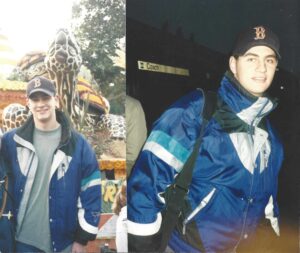
Matthew Barnard, Principal, Los Angeles
“I was a senior in high school in North Orange County and loved my sleep. The earthquake definitely woke me but even still, I don’t remember even getting out of bed until the shaking was over. We knew it was a big one but not that close. We did not have a TV so it was not until we turned on the radio to AM 1070 and heard the initial reports that we realized that this earthquake was truly something big.”
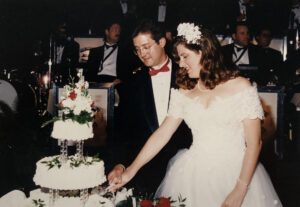
Deena Weiner-Widran, Business Development Manager, Los Angeles
“I got married and moved from Chicago to Studio City, about 13 miles from Northridge, for my husband’s new job in June of 1993. At about 4:28 am on January 17, we were sound asleep with our three cats on our bed. Suddenly, one of the cats shot straight up into the air. Suspended in midair with his feet moving like a cartoon, he shot forward and took off waking up both my husband and me. As we were commenting on how strange the cat’s behavior was, the earthquake hit- It felt like a giant was holding our bed and violently shaking it up and down. We could hear bookcases falling over and glass breaking throughout the house. The shaking felt like it lasted forever.
Somehow, we were able to climb over all of the furniture and other items that were knocked over and strewn about the room, put on mismatched shoes that we dug out of the closet (everything had fallen off of the racks and shelves and was piled in the middle of the floor), grab the one visible cat and run outside. All of our neighbors were standing around and we watched together as one transformer after another blew out up in the hills, some starting fires. All of the water heaters fell over and broke and it looked like multiple waterfalls running along the back of the building. My husband borrowed a flashlight and went back into our place to grab coats or blankets (it was cold outside), the remaining cats and cat carriers. We all stayed outside together until the sun came up and we could see just how bad the situation was inside.
Our tempered sliding door had shattered and all of our wedding dishes, glassware and kitchen gear was broken. There were many aftershocks and during a large one, the power lines snapped off the pole directly above our heads. My husband jumped out of the way just in time and we watched the power line burn through the curb. Phone service worked intermittently (no cell phones then) and we were able to call the fire department about the downed power line. When our place was finally inspected, we were yellow tagged. Our bedroom had a twenty-foot high ceiling with clerestory windows right above our bed. The wall behind our bed had buckled and the clerestory windows had begun to pop out of their frame. Had the windows popped out completely, I might not be here today writing about my experience. It took weeks to clean up all of the broken glass and debris, but the experience still lingers with me to this day.”
Others recall their experience while on reconnaissance after the earthquake:
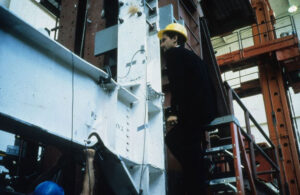
Jorn Halle, Senior Principal, Oakland
“Ray Pugliesi (pictured above) and I were doing post-earthquake reconnaissance at a house that was located on a hillside.You entered the house at the upper floor, and the lower floors were down the hill and there was a crawl space. I was talking to the homeowner, who was in the movie business, I forget his name but he was semi-famous. Ray was down the hill and underneath the house. He’d crawled underneath the house and was looking at the cripple wall at the very front. The only way out was to go down the hill, through the door, out along the house and back up along the side. I’ll never forget this aftershock struck while Ray was underneath. He split! He was out the door and around and up so quickly. That was one of our first experiences with aftershocks. It was pretty funny. Not being down there, but seeing him come running up.”

Stacy Bartoletti (Pictured on right with David Bonneville, Senior Principal on left), CEO, Chairman, Principal, San Francisco
“I started my career with Degenkolb in 1993, when the company had a single office in San Francisco and approximately fifty people. After working for the firm for only seven months, the Northridge Earthquake hit. I don’t remember when exactly I heard about it, but once I arrived into the office that day we were already in discussions with a high tech client about surveying their buildings impacted by the earthquake. They were still making up their mind on whether they wanted us to come down immediately or wait until later. We ended up deciding for them as David Bonneville and I went out the very next day. We ended up staying for several days after that to continue surveying the building damage with David acting as Principal-in-Charge.
Damage to one of the buildings actually triggered some fairly significant changes to the code for steel braced frames. On the exterior, the building had very little damage and no indication of structural damage. The interior was a mess with ceiling tiles, sprinklers and lighting fixtures fallen everywhere. While David and I walked the building with contractor Rudolph & Sletten, we noticed in a stairwell that a section of gyp board was punched out.

Knowing that there were brace frames located behind the stairwell walls and after consulting the seismic evaluation we completed for the building prior to the earthquake, we had Rudolph & Sletten open it up. We ultimately discovered that every brace in one direction on the second floor was broken. Because David had experienced a similar situation for one of this client’s northern California buildings in the prior Loma Prieta earthquake and the fact that we knew the buildings structural system from preparations prior to the earthquake, we quickly found the major damage. Had an emergency volunteer inspector evaluated the building they likely would not have found it.
Due to circumstances with the way that the lease was written for this particular building, we had to have it fully operational in only 90 days. From the initial evaluation to a fully repaired building we met this extremely short deadline. Because of the quick turn-around time, I was essentially living in Southern California for the entire duration. That project is still one of my most memorable experiences during my 26 year career. The work we did and the relationship built with our client really impacted the growth of my career. It was such a great opportunity that I will never forget.”

Jim Malley, Group Director and Senior Principal, San Francisco
“We had just completed work on VA Palo Alto after the Loma Prieta earthquake, turning in the final set of drawings on Friday January 14. The following Monday morning I heard on the radio about the Northridge earthquake and by that night I was on my way down to Burbank to do reconnaissance for VA Sepulveda. When we walked onto the site at 8am on Tuesday, there were many people milling around outside. We asked why no one was in the building and they said they didn’t want to go in until we said it was safe. There was water streaming out of the doors of the building because the water had shut off during the initial earthquake, but had turned back on afterward and flooded the building. They did not want to send a plumber into the building until we said that it was safe to do so. We went in for about 10-20 seconds and came out telling them it was safe for the plumber to turn off the water.
While on the campus we were asked to check the boiler plant, a concrete building with sheer walls. The building had significant cracking to the columns and we advised against entering the building for more than a few minutes at a time. They could not occupy their offices. A couple of days later, we were evaluating an adjacent building when a large aftershock hit. We were near the entrance to the boiler plant and saw one of the maintenance guys run straight out of there knowing we had yellow tagged the building. Once the aftershock subsided, we went into the boiler plant to see if the damage got worse. While we were observing how the aftershock had affected the previously formed building cracks a LARGER aftershock hit and we ourselves ended up running out same as the maintenance worker we had seen earlier. As we were getting out of the building all I could think was “Here I am, about to die in a building I’ve already condemned”.
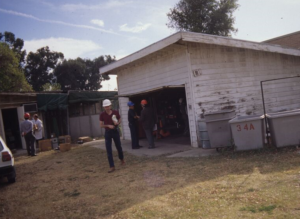
The Northridge earthquake actually changed my career. 3-4 months later, significantly damaged steel moment frame buildings were discovered and AISC called a meeting to address the problem. FEMA, ATC and SAC formed a joint venture to study the problem which resulted in a mandatory inspection program that took place in 1995-1996. Buildings were subsequently repaired in the San Fernando Valley and West LA, but not in Downtown LA because it didn’t meet the shaking threshold. I was the project director for SAC on both the first 1995-1996 inspection phase and the second phase which took 50% of my working hours for 5 years. I’ve helped lead the changes to steel moment frame guidelines since the Northridge earthquake.
The Northridge earthquake not only affected my professional career, but also the growth of the company. With all the work we were performing in southern California after the earthquake, we opened our first office in Los Angeles in 1995.”
The Northridge earthquake played a major part in the development of Degenkolb’s Los Angeles office and expansion. Let’s see where our current southern California staff was in 1994:

Daniel Zepeda (pictured on the right), Principal, Los Angeles
“I was living in Fontana and in the middle of my high school years not even thinking of structural engineering”
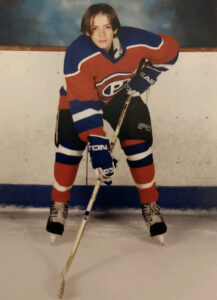
Michael Braund, Principal and Office Director, San Diego
“I was living in Pittsburgh playing competitive hockey with a skater haircut.”
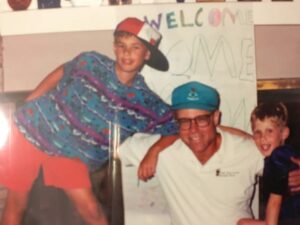
Sandy Hohener (Pictured on left), Associate, Los Angeles
“I was rocking that 90s style quite well.”

Chad Closs, Associate, San Diego
“I was in elementary school growing up in San Diego and vaguely recall small earthquakes here and there during my early childhood. We always ran under door frames as a family. Little did I know, at that time, that one day I’d be designing buildings to resist them.”
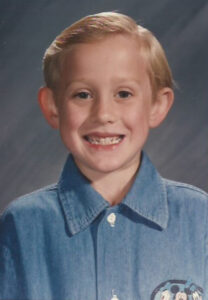
Garrett Hagen, Project Engineer, Los Angeles
“I was just beginning my schooling years in Atascadero, CA. In fact, this would have been my first school picture ever (apparently the Mickey Mouse collared shirt made the cut.) Note, “Atascadero” translates as “mud-hole” or “the place you get stuck” but I eventually made it out.”
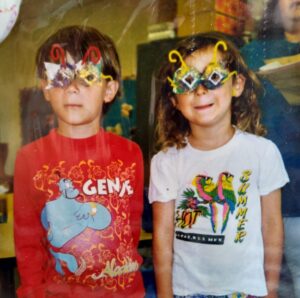
Carmen O’Rourke (Pictured on the right), Designer, Los Angeles
“During the Northridge Earthquake, I was in first grade, living in San Diego. I didn’t learn about the earthquake until years later, when I attended grad school in Los Angeles.”

Daniel Phelan, Designer, Los Angeles
“When the Northridge Earthquake happened I was still a year and a half out from being born. So as you can see in the photo above, my parents were busy enjoying a life without any kids.”
